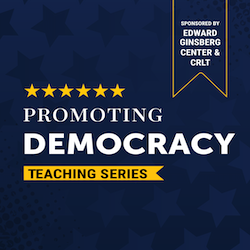In October 2015, CRLT hosted a U-M faculty panel that addressed challenges and strategies for teaching about difference and privilege. In this post, we spotlight some key moments when faculty described tensions or difficulties, and we suggest strategies for leveraging these for student learning.
The panel featured four LSA faculty members:
-
Ruby Tapia, Women's Studies and English (video unavailable)
(Click on a panelist name to see a video of their talk, or see the embedded videos at the end of this post. Each video runs 8-9 minutes.)
"Several years ago, I was teaching a class on social identity and we were talking about whiteness. Actually, we weren't talking about whiteness. That was the problem." (Al Young)
What happens when discussions about race and privilege turn silent? Faced with the dynamic described above, Young asked students to turn their lens to analyzing the silence they were experiencing by writing a minute paper on the stalled conversation: "What's the problem right now with the conversation on white identity?" After writing for 3-5 minutes, he finds students are more likely to voice their thoughts out loud. For silent or superficial discussions, Helen Fox (2009) also recommends having students write on an index card, "One thing I've been reluctant to say....," which serves as a prompt for follow-up discussion.
“We’re teaching about privilege because privilege is pervasive but knowledge about it is not….Your students, they don’t come in getting it.” (Ruby Tapia)
Panelists described how they brought into their classrooms multiple structures that helped scaffold discussions about privilege, because many students are unaccustomed to having these conversations. Some, like Tapia, used syllabus statements that previewed the nature of course content and modes of interacting (e.g., “This course engages material that challenges established knowledge and assumptions about gender and other social categories”; other examples used by Portnoy can be found in this collection of resources from the panel). Likewise, sociologist Jay Howard (2015) presents research about the importance of being explicit with students about the rationale for active learning (e.g., why speak in a class discussion?) and “what counts” for participation, due to diverse student understandings about the nature and value of these activities.
Guidelines about productive discussions also are useful for creating intentional participants. During the first days of her class, Alisse Portnoy asks students to generate “tips” for discussion, such as using “I statements,” taking turns, and supporting people. To reinforce these behaviors throughout the term, she sends a few positive emails after some classes to praise students for a good discussion.
"It’s much less about me telling them about privilege than showing how it plays out and getting them to think through it on their own.” (Stephen Berrey)
Education researcher Jeffrey Milem (2003, p. 4) summarizes the research on student diversity by noting that there are positive learning outcomes (e.g., complex and critical thinking) when “students are influenced by the interactions that they have with diverse ideas and information as well as by the interactions that they have with diverse people.” Therefore, classrooms that engage students with interactive pedagogies -- such as think-pair-share, paired discussions over texts, or teams and groups -- are more likely to reap these gains. Tanner (2013) offers a number of similar strategies for student engagement in STEM classrooms. In large-group discussion format, Berrey notes that good discussion starters include images, historical examples, or music, while Portnoy offers a list of critical reflection questions to spark discussion.
“It’s very helpful to have people to talk through those moments so that I can get back on the court and keep doing the work.” (Alisse Portnoy)
Teaching about privilege is difficult work. Panelists noted the helpfulness of having a trusted person to call to debrief a class, as well as using midterm student feedback to check in with students. Faculty can also help students navigate challenging moments. Panelists described the importance of sometimes slowing down discussion -- for example, asking students to write during a hot moment -- as well as modeling thoughtful, deliberate responses to tensions. For example, Portnoy notes that when she feels uneasy about a comment, she might say, “You know, something got said and I can’t quite figure out why it’s just not sitting right with me. I’m going to give it some thought...but I want you to know that we’ll come back to it next class.”
CRLT is available to consult with you about these topics in your own teaching. Call or submit an online request if you’d like to schedule a consultation.
Sources Cited:
Fox, H. (2009). “When race breaks out”: Conversations about race and racism in college classrooms. New York: Peter Lang.
Howard, J. (2015). Discussion in the college classroom: Getting your students engaged and participating in person and online. New York: Wiley.
Milem, J.F. (2003). The educational benefits of diversity: Evidence from multiple sectors. In M. Chang, D. Witt, J. Jones, & K. Hakuta (Eds.), Compelling interest: Examining the evidence on racial dynamics in higher education (pp. 126-169). Palo Alto, CA: Stanford University Press.
- Log in to post comments
- 1681 views






